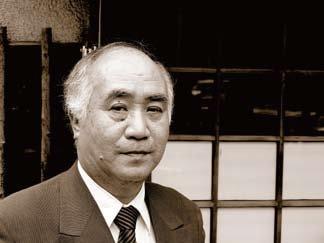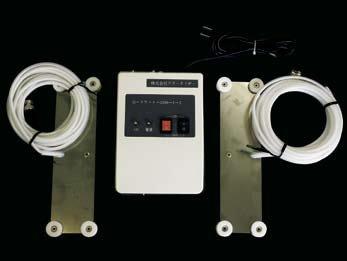Technology -- Fry up, Worry Down
By Hugh Ashton
How one Tokyo entrepreneur is taking the heat off fried foods
For a long time, it has been known that deep-fried foods cause health problems. Not only do French fries, a guilty pleasure for many, increase their eaters’ weight, with all the health risks associated with obesity, but the oil oxidizes at the temperatures associated with frying starchy foods and oxidized oil poses many questions regarding health. Worse still, starchy foods (fries, potato chips and breadcrumbed food such as tonkatsu and croquettes), cooked in fat heated to above 160 C (320 F) contains significant amounts of acrylamide, a suspected carcinogen, which was the subject of a lawsuit won last year by the State of California against several major food manufacturers. Fried foods can also produce other chemicals which are judged to cause long-term problems.
 Takeshi Hara, president of Tokyo’s Greenizer Co., Ltd.
Takeshi Hara, president of Tokyo’s Greenizer Co., Ltd.
Wouldn’t it be great if there was a way to enjoy these fried treats without continually having to worry about the possible dangers to one’s health? In fact, simply reducing the temperature of the oil in which the food is cooked by 10 C (18 F) provides a number of benefits. The amount of acrylamide is significantly reduced, for a start, and this has a number of possible health benefits.
Food fried at a lower temperature also absorbs less fat—helping the obesity problem— and where the fats used are trans fats (banned in a number of jurisdictions as a result of their possible adverse effects on health), other health-related benefits accrue. But how to fry at this lower temperature and keep the food tasty and appetizing? Takeshi Hara, President of Tokyo’s Greenizer Co., Ltd., thinks he has the answer, and his customers, including a major Japanese restaurant chain, agree with him. The G-Fryer works on principles which are not entirely new, but have been refined by a number of researchers, many of them from China.
The G-Fryer is deceptively simple in appearance. The basic model consists of two parts: the control unit and an electrode (larger models, such as the one pictured here, have two electrodes). No special installation is needed—simply a connection to a standard domestic wall socket and a safe place for the control unit. The electrode is then placed in the frying oil, and when switched on, delivers direct current electricity at about 2,000 volts. This sounds dangerously high, but a smiling Hara switches on a demonstration unit, holds the electrode in one hand, and a circuit tester in the other, which lights up, showing that the 2,000 volts is passing through his body! The secret to this death-defying stunt is that the current passing through is extraordinarily low—less than two milliamps, which makes it safer than an ordinary light socket. However, this mysterious negative DC high voltage seems to result in a number of highly beneficial effects, many of which also have subsequent practical benefits.
Since the oil’s thermal conductivity is increased, food can be cooked at a lower temperature, thereby reducing the number of calories by anything up to 25 percent. In one test involving 100 croquettes cooked using the G-Fryer, the weight of the cooked food was less than that of the frozen uncooked croquettes (possibly due to water loss from the frozen food). Not only that, but the tasting panel overwhelmingly voted for the croquettes cooked in this way. The “greasy lip” syndrome can be a thing of the past, claims Hara.
 Tokyo-based company Greenizer’s G-Fryer
Tokyo-based company Greenizer’s G-Fryer
One very important factor for the operators of frying equipment, as opposed to the consumers, is the fact that the G-Fryer’s voltage reduces oxidization. As well as the health benefits, the oil used in G-Fryer-equipped installations lasts significantly longer—up to twice as long as usual, says Hara. This means that a fast food or restaurant chain can reduce costs and increase the efficiency of frying operations. With the cost of soybean oil having doubled in fall 2008, compared to the price three years prior (to take just one example), such a saving in material costs is far from trivial for any operation relying on fried food as a staple product. Indeed, it is estimated that the cost of a G-Fryer can be recouped through the savings in oil costs alone within about nine months. Add to this the cost of labor involved in oil changes, and the fact that the cooking area stays cleaner as a result of lower fat temperatures, and overall labor costs for the whole operation are also significantly reduced. This becomes a very significant factor when the G-Fryer technology is applied to large-scale industrial frying applications—indeed, the largest such unit is capable of handling frying operations using up to 1,500 liters of oil.
In addition, the reduced amount of dirty cooking oil and the reduced power used for cooking, make owners of the G-Fryer “greener” than their less sophisticated counterparts.
As mentioned above, a major Japanese restaurant chain is already using this patented technology with success, and a Japanese distributor of a major electrical maker already includes the G-Fryer in its catalog, together with Greenizer’s related negative DC high voltage “stay fresh” system for use in refrigerators. But while there is still room for expansion in the domestic Japanese market, Hara sees opportunities for the G-fryer in other countries, such as the United States, where fried foods form a larger part of the diet than they do in Japan and where the amount of oil used is correspondingly greater. Accordingly, he is seeking distribution partners who can produce overseas versions of the G-Fryer under license, meeting local requirements for power and safety standards, etc.
It’s rare to find a product claiming to improve health, work for the benefit of the environment, and make food taste better. If Hara can realize his dreams, we can look forward to a world of happier, healthier (and more guilt-free!) eaters of fried food.





